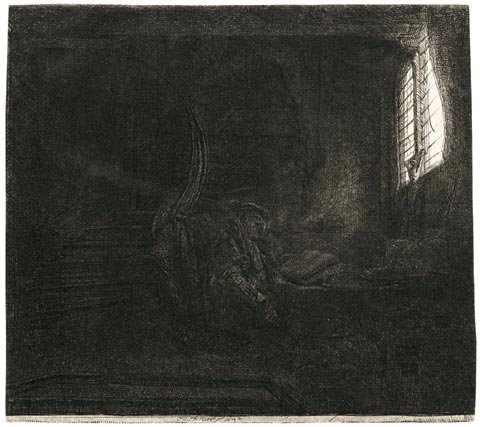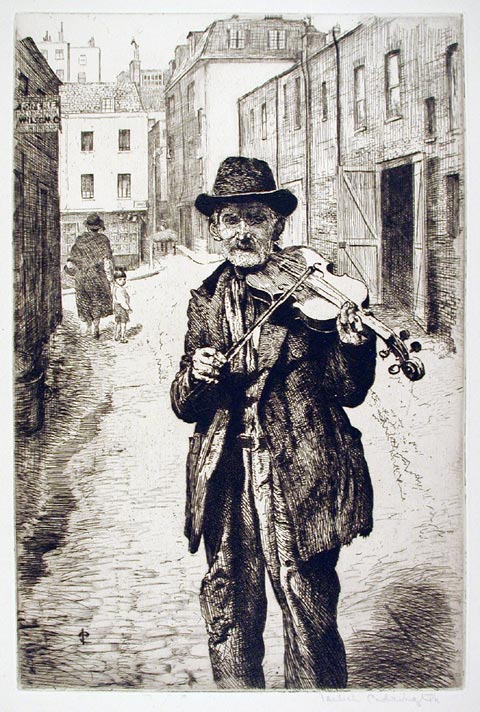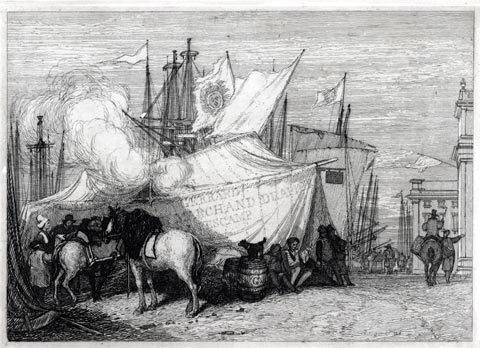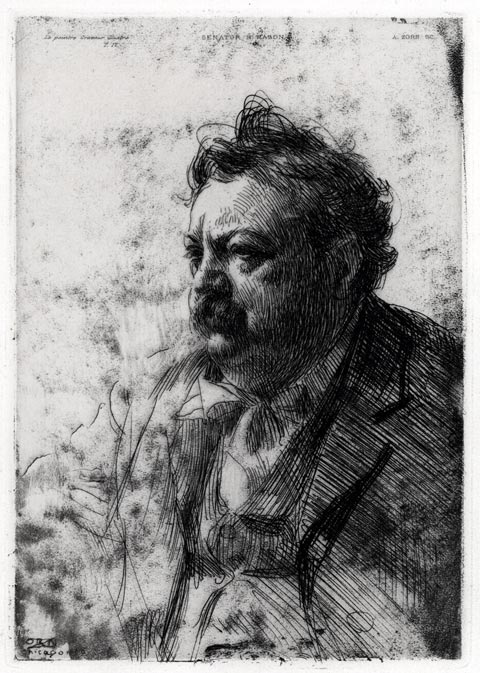The
Home Page Selection
If
you require further information on any
print featured here, please contact
us.
When
a print has been sold it will be marked
as Sold.
A
growing archive of selections
from previous Home pages is featured in
the
Home
Page Selection Archive |
|
See
also :
Click
on a thumbnail (left)
to link directly with the entry for that
print, or scroll down to view all the selected
prints from the current Home
Page.
Images
are not to relative scale (see stated dimensions) and also at only modest resolution.
If you wish to view extracts of an image at higher resolution, please Contact us.
|
|
|
|

| |
REMBRANDT HARMENSZ. VAN RIJN
Leiden 1606 – 1669 Amsterdam
St Jerome, either in prayer in the ‘wilderness’ or studying or writing his translation
of the Bible from Greek into the Latin vulgate, was a subject that Rembrandt obviously
found sympathetic. He painted the saint a number of times and made seven etchings
on the theme. Of his other plates representing saints he etched only a single plate of
St Francis, a single plate of St Stephen, a single plate of St John the Baptist, and
three of the Apostles Peter & John.
St Jerome in a dark Chamber
New Hollstein 212 ii-iii/iii; Bartsch 105 ,Hind 201 ii/ii
150 x 168 mm (sheet)
Original etching, 1642.
Tthe plate signed and dated at the lower edge.
A later impression, darkly printed, on laid paper.
Trimmed to the plate at the top and foot;
and fractionally into the subject at the sides.
£2800
Ex collection Audrey Gibbs
Rembrandt quite frequently portrayed a single figure in an interior dimly lit by a single window,
though no others show an interior so extremely dark that many of the details are obscured.
In this impression they are mainly only to be seen from the reverse when the sheet is held up to
the light. Such is the case with the usual iconographical ‘attributes’ that identify St Jerome:
the cardinal’s hat (hanging to the right of the staircase); the skull (on a ledge at the back of the room);
his lion (added at Jerome’s feet in the second state); only the crucifix directly in front of the window
can be easily made out.
The composition of the cogitating saint seated near the window in a room with a winding spiral
staircase is closely related, in reverse, to a painting in the Louvre, attributed to Rembrandt
(with a signature and date of 1632) known as the Philosopher in Meditation (but thought actually
to represent Tobit and his wife awaiting the return of their son Tobias).
Return to top ^ |
|
|
|

|
|
ISABEL CODRINGTON
Swimbridge 1874 – 1943 Minehead
For information please visit my web exhibition of Isabel Codrington's Etchings.
The Old Violinist
302 x 200 mm
Original etching, c1930.
The plate monogrammed.
The impression signed in pencil; and entitled by the artist in the lower margin.
Edition of 40.
On cream wove paper.
£300
Illustrated in Fine Prints of the Year 1933.
An impression was exhibited at Colnaghi in Etchings by Isabel Codrington, June 1933.
Provenance: The artist’s estate and by descent to her grandson.
Malcolm Salaman explained in the preface to the 1933 volume of Fine Prints of the Year,
why he had chosen to illustrate the “characteristic figure of The Old Violinist” in preference
to Codrington’s “accomplished landscapes”, also on show at the time in the exhibition at Colnaghi.
He is playing his way slowly along the poor street, his worn fingers touching
the strings in no uncertain fashion, though his bowing is not perhaps what it was
in his younger and more showy days. But there is something in the tone or the tune
that attracts a small boy ambling along with his marketing mother. This etching is
suggestive, the face, figure and clothes of the man show wear, but the fiddle is being
strummed with a reminiscence that the child seems to recognise.
Codrington enjoyed adding distant figures to her etched street scenes, enhancing the narrative element.
An unsigned impression is also available (£150).
Return to top ^ |
|
|
|
 |
|
JOHN SELL COTMAN
Norwich 1782 – 1842 London
Cotman was the most prolific etcher of the Norwich School and said he wanted his etching
to be “something well worth having lived for”.
Fécamp
Popham 349
204 x 283 mm
Original etching, c.1820.
Unpublished in Cotman’s lifetime.
Issued by Charles Musket in Eight Original Etchings by the late John Sell Cotman,
now first published, Norwich, 1846.
On laid china paper on wove.
£300
The British Museum have the preparatory drawing and another small related sketch
(as well as a counterproof impression). Cotman used the same preparatory sketch
in 1820-21 to make a finished, dated, drawing of the subject, now in Norwich Museum.
Cotman visited Fécamp twice, in 1817 and again in 1820.
Please visit my web exhibition to see more etchings by Cotman and other etchers of The Norwich School.
Return
to top ^ |
|
|
|
 |
|
ANDERS ZORN
Mora, Sweden 1860 – 1920 Stockholm
Zorn learnt the practicalities of the etching process in London with fellow Swede Axel Haig
in 1882, though his inspiration came from Rembrandt.
On his way back to Sweden in 1883 he visited Amsterdam to pay his “respects to the old boys,
Rembrandt, Hals etc”.
In later years he had a cabinet, designed by himself, reserved for housing only two artists’ etchings,
Rembrandt’s and his own. Zorn had a collection of 180 Rembrandt etchings.
Of humble origins, the illegitimate son of a German brewer and a Swedish country girl,
Zorn grew up on his grandparents’ farm, near Mora. Educated locally, at the age of fifteen
he went to Stockholm as a student at the Royal Swedish Academy of Arts.
He obtained international success as a painter, sculptor and etcher, gaining special celebrity
in the United States which he visited seven times, painting the portraits of three Presidents.
Senator Billy Mason
Hjert & Hjert 107 ii/ii; Asplund 159, Delteil 158
198 x 141 mm
Original etching.
The plate signed and dated Chicago 1900.
Second (final) state,
with Delteil’s Le Peintre- Graveur lettering at the top.
Published 1909 in Volume IV,
total edition of 400 unsigned.
(There was also a separate signed edition of 40,
before the Peintre- Graveur inscription).
On cream laid paper.
£250
Billy Mason was etched in Zorn’s Chicago studio on Zorn’s fourth visit to the U.S.A.
Mason served two periods of office as Senator for Illinois.
He also is said to be the originator of a style of waistcoat particularly suited to stout people and warm weather.
Return
to top ^
|
|
|
|
|
|
|
|